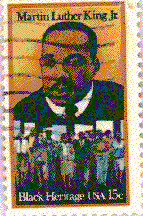FRtR > Outlines > American History (1990) > Chapter Eight > The Progress of American Blacks (13/22)
An Outline of American History (1990)
Chapter Eight
The Progress of American Blacks (13/22)
< Previous Page * Next Page >
During the 1960s the country made progress toward
eliminating racial discrimination. Between 1954 and 1960, 765 out of
the 6,676 school districts in the South had been desegregated.
Between 1961 and 1964, some 365 additional school districts
admitted black students to formerly all-white schools, increasing
by almost 50 percent the number desegregated during the
previous seven years. Peaceful sit-ins by black and white college
students, starting in February 1960, sped the end of segregation
in restaurants and at lunch counters in more than 500-southern
communities.
In 1961 came the freedom rides--orderly, nonviolent
protests against segregation in bus transportation and terminal
facilities. In November 1961 the Interstate Commerce Commission
banned segregation in all interstate travel. The following year the
U.S. Supreme Court unanimously endorsed this ban, stating:
We have settled beyond question that no state shall require racial
segregation of interstate and intrastate transportation facilities.
What came to be called the Civil Rights revolution reached
a dramatic climax in 1963. After massive black demonstrations in
the segregated deep-south city of Birmingham, Alabama,
President Kennedy told the nation in a
televised speech that it had
a moral obligation to secure full equality for black Americans.
televised speech that it had
a moral obligation to secure full equality for black Americans.
 He then proposed to Congress the most
sweeping legislation in
this century to eliminate discrimination in voting, education,
employment, and public accommodations. On August 28, more
than 200,000 blacks and whites, led by the black southern
minister
Martin Luther King Jr.,
marched to the Lincoln Memorial
in Washington in an impressive demonstration that drew
heightened national attention to the demand for equal rights. In 1964,
Dr. King received the Nobel Peace Prize in recognition of his
decade-long leadership in Christian, non-violent protest against
discrimination.
He then proposed to Congress the most
sweeping legislation in
this century to eliminate discrimination in voting, education,
employment, and public accommodations. On August 28, more
than 200,000 blacks and whites, led by the black southern
minister
Martin Luther King Jr.,
marched to the Lincoln Memorial
in Washington in an impressive demonstration that drew
heightened national attention to the demand for equal rights. In 1964,
Dr. King received the Nobel Peace Prize in recognition of his
decade-long leadership in Christian, non-violent protest against
discrimination.
The Kennedy administration further advanced racial
equality by appointing many eminent blacks to high government posts.
Some of the more notable appointments were Robert C. Weaver
as head of the Federal Housing and Home Finance Agency, and
Thurgood Marshall, formerly chief counsel of the National
Association for the Advancement of Colored People, as a federal
judge. Dozens of other black Americans gained appointment
to positions ranging from presidential assistant to ambassador.
With more than 240,000 black students attending institutions
of higher learning in 1964, there was reason to believe that the
trend toward better jobs and more influential roles in
government for blacks would be hastened.
< Previous Page * Next Page >
 He then proposed to Congress the most
sweeping legislation in
this century to eliminate discrimination in voting, education,
employment, and public accommodations. On August 28, more
than 200,000 blacks and whites, led by the black southern
minister
Martin Luther King Jr.,
marched to the Lincoln Memorial
in Washington in an impressive demonstration that drew
heightened national attention to the demand for equal rights. In 1964,
Dr. King received the Nobel Peace Prize in recognition of his
decade-long leadership in Christian, non-violent protest against
discrimination.
He then proposed to Congress the most
sweeping legislation in
this century to eliminate discrimination in voting, education,
employment, and public accommodations. On August 28, more
than 200,000 blacks and whites, led by the black southern
minister
Martin Luther King Jr.,
marched to the Lincoln Memorial
in Washington in an impressive demonstration that drew
heightened national attention to the demand for equal rights. In 1964,
Dr. King received the Nobel Peace Prize in recognition of his
decade-long leadership in Christian, non-violent protest against
discrimination.